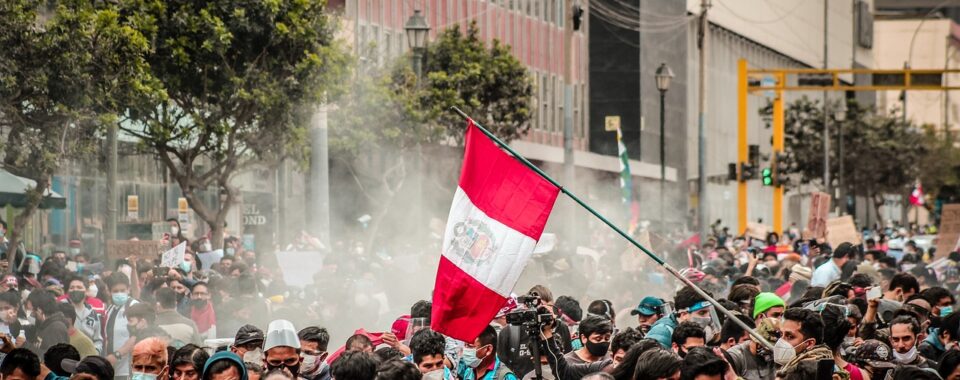BY MELINDA ELLINGTON
Peru steadily improved on the Fragile States Index from 2006, with a sharp reduction in poverty,[1] and improvements in literacy,[2] infant mortality,[3] and life expectancy.[4] But against a backdrop of high inequality, since the COVID-19 pandemic in 2020 the country has veered sharply toward greater fragility, and in 2022 was among the most worsened overall. In a political system fraught with division pitting the interests of indigenous, rural, and working-class people against the urban, elite minority, [5] a sharp increase in inflation and riots over fuel prices worsened an already volatile situation. In December, left-leaning President Pedro Castillo unsuccessfully attempted to dissolve Congress to forestall impeachment for alleged corruption.[6] The move backfired. He was impeached and detained, leading to widespread protests, a state of emergency, and clashes that resulted in dozens of deaths.
Peru exhibited significant improvement in the economy since the 1990s[7] with the second-highest economic growth in South America through 2015 and a reduction of nationwide poverty by almost 40 percentage points during that time.[8] However, inequality has remained high with a Gini Index score of 40.2 in 2021.[9] Food insecurity has been increasing, with over half the population considered moderately or severely food insecure in 2020.[10] And during the COVID recession the poverty rate spiked[11] to rates not seen in a decade. Peru had the highest per-capita death rate from COVID-19 in the world in 2022,[12] with the brunt of this health crisis falling on the poorest and most disenfranchised communities.
The war in Ukraine exacerbated these pressures, with soaring prices for fertilizer, food, and fuel.[13] As a result, Peru had its highest inflation rate in 24 years at 8.45%[14] which had a regressive impact on the most impoverished members of Peruvian society, further exacerbating regional and class tensions. In an attempt to mitigate these pressures, the government suspended the gas tax.[15]
President Castillo was a political outsider from rural Peru, who was elected in a runoff election in June 2021 despite having garnered a mere 19% plurality during the first round of voting.[16] While many hoped he would be able to usher in change as one of the first political leaders with no ties to establishment politics, the absence of a mandate or allies within Congress led to an embittered struggle that stalled policy progress on all fronts.[17] Within months of his assuming office, there began multiple attempts to impeach him on a range of charges from “moral incapacity” to corruption. Congress further attempted to constrain Castillo’s ability to effect policy through the removal of cabinet members. Finally, in December 2022, President Castillo declared the dissolution of Congress and the installation of a new government to rule by decree.[18] But without the backing of the military or state police, the plan failed, and he was quickly removed and replaced by his Vice President Dina Boluarte in less than 24 hours.[19] This turn of events led to weeks of protests by supporters of Castillo that frequently turned violent, with both protestors and journalists being attacked by police and security forces.[20] Newly instated President Boluarte declared a 30-day state of emergency, suspending the right to assembly, in an effort to quell ongoing violence and rising protests in rural and Indigenous communities around the country.[21]
These events were met with mixed reactions from state leaders in the region, with left-leaning governments such as Mexico, Argentina, Bolivia, and Colombia supporting ousted President Castillo, while the United Nations, United States, Canada, and the European Union largely supporting Peru’s right-wing Congress and President Boluarte.[22]
So far in 2023, the country has experienced ongoing protests and violence, with road blockages further exacerbating food shortages.[23] Protestors are demanding the closure of Congress, constitutional reform, and new elections.[24] Allegations of targeted repression of Indigenous groups, rural workers, and journalists have prompted calls for accountability of Congress and a swift, bloodless resolution to the turmoil that threatens to further increase fragility.[25]
Findings from FFP’s Crisis Sensitivity Simulator suggest that for a country like Peru, even where the long-term trends in the Fragile States Index are positive overall, there are particular combinations of shocks (e.g., a health crisis affecting public services in the context of political controversy) that can be uniquely destabilizing, in comparison to other types of challenges. If Peru is to become more resilient, it will need to do more than to resolve the immediate problem. Peru must address the issues of inequality and social cohesion that have persisted for decades. Otherwise, the next time there is a similar shock, it will cycle back into chaos.
[1] https://data.worldbank.org/indicator/SI.POV.NAHC?locations=PE
[2] https://data.worldbank.org/indicator/SE.ADT.LITR.ZS?locations=PE
[3] https://data.worldbank.org/indicator/SP.DYN.IMRT.IN?locations=PE
[4] https://data.worldbank.org/indicator/SP.DYN.LE00.IN?locations=PE
[5] https://www.usnews.com/news/best-countries/articles/2022-12-22/explainer-how-peru-plunged-into-political-crisis-and-protests ; https://www.bbc.com/news/world-latin-america-63971274
[6] Peru’s president dissolves congress hours before impeachment vote | Peru | The Guardian
[7] https://www.oecd-ilibrary.org/sites/d9afdddd-en/index.html?itemId=/content/component/d9afdddd-en
[8] https://www.imf.org/external/np/blog/dialogo/100115.pdf
[9] https://data.worldbank.org/indicator/SI.POV.GINI?most_recent_value_desc=true&locations=PE
[10] https://data.worldbank.org/indicator/SN.ITK.MSFI.ZS?locations=PE
[11] https://data.worldbank.org/indicator/SI.POV.NAHC?locations=PE
[12] https://www.statista.com/statistics/1104709/coronavirus-deaths-worldwide-per-million-inhabitants/
[13] https://news.un.org/en/story/2022/11/1130737
[14] https://www.bloomberg.com/news/articles/2022-12-07/peru-hikes-interest-rates-after-inflation-tops-all-forecasts#xj4y7vzkg
[15] https://www.reuters.com/world/americas/peru-suspends-some-fuel-taxes-fight-price-surge-2022-04-03/
[16] https://www.americasquarterly.org/article/pedro-castillo-and-the-500-year-old-lima-vs-rural-divide/
[17] https://apnews.com/article/politics-peru-caribbean-covid-6921c3c8bcf95f654b70d8de39dfc550
[18] https://www.theguardian.com/world/2022/dec/07/peru-parliament-dissolved-impeachment-vote-coup-fears
[19] https://www.bbc.com/news/world-latin-america-63971274
[20] https://www.amnesty.org/en/latest/news/2022/12/peru-crisis-human-rights/ ; https://apnews.com/article/politics-peru-caribbean-covid-6921c3c8bcf95f654b70d8de39dfc550
[21] https://apnews.com/article/politics-peru-caribbean-covid-6921c3c8bcf95f654b70d8de39dfc550
[22] https://www.cbc.ca/news/world/peru-political-crisis-president-1.6689867
[23] https://www.amnesty.org/en/latest/news/2023/03/peru-racist-repression-slow-investigations-100-days/
[24] https://www.ohchr.org/en/press-releases/2023/03/peru-un-experts-call-end-violence-during-demonstrations-urge-respect-human
[25] https://www.hrw.org/report/2023/04/26/deadly-decline/security-force-abuses-and-democratic-crisis-peru
